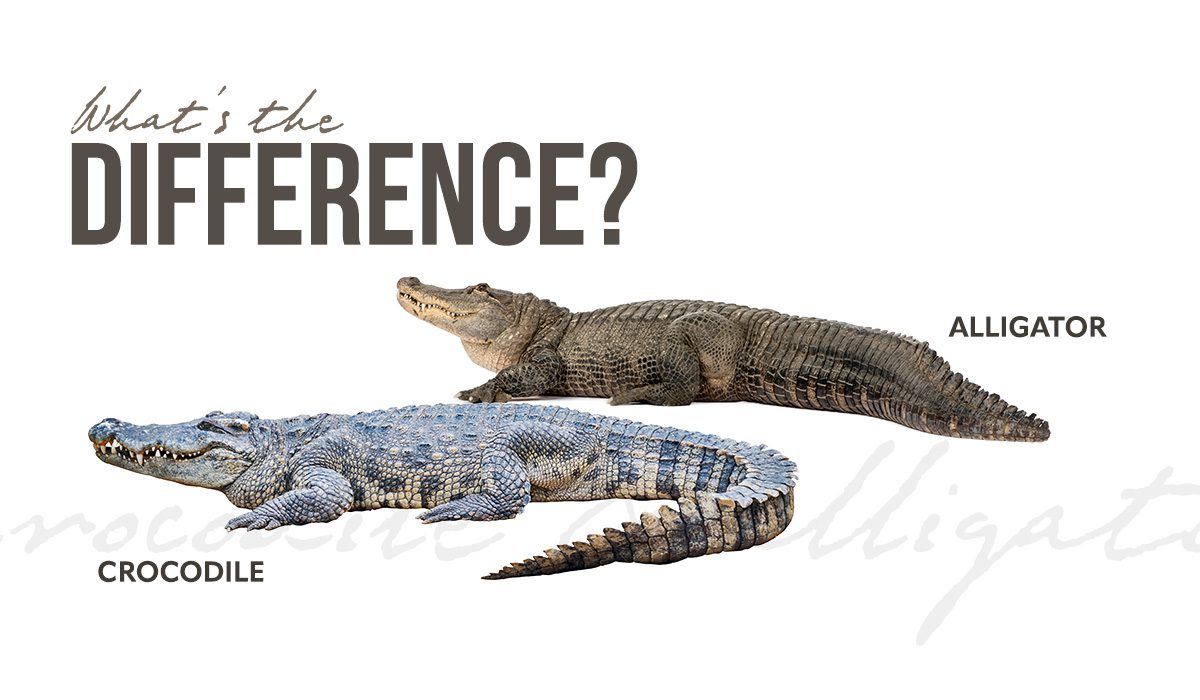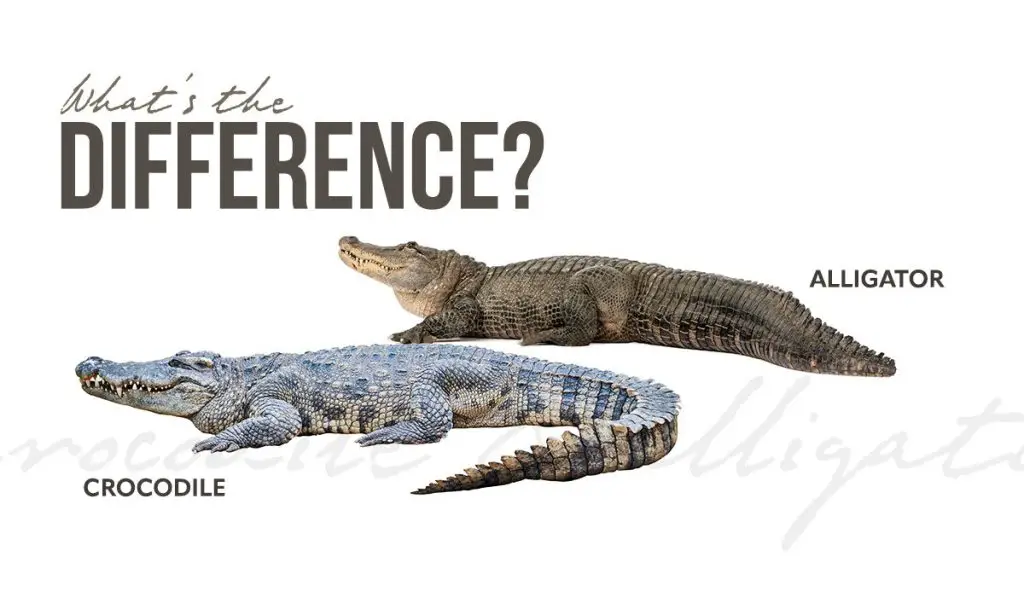Alligators and crocodiles are often confused with each other due to their similar appearance. However, these two species are actually quite different from each other. In this article, we will explore the unique characteristics that set alligators and crocodiles apart from one another. So, let’s dive in and discover what makes these reptiles so distinct.
Alligators and crocodiles are both large, carnivorous reptiles with long snouts and powerful tails. However, there are several key differences between the two. Alligators have a broader, U-shaped snout, while crocodiles have a longer, V-shaped snout. Alligator teeth are hidden when their mouth is closed, while crocodile teeth are visible. Alligators are found primarily in the United States and China, while crocodiles are found across the world in Africa, Asia, Australia, and the Americas.

What Are the Differences Between Alligators and Crocodiles?
Alligators and crocodiles are often confused with each other due to their similar appearance and habitat. However, there are several key differences that set them apart. In this article, we will explore these differences and learn how to identify each species.
Physical Differences
Both alligators and crocodiles belong to the reptile family, but they have distinct physical features. One of the most noticeable differences is their snout shape. Alligators have a wide, rounded snout, while crocodiles have a longer, more pointed snout. Additionally, alligators have a more U-shaped jawline, while crocodiles have a V-shaped jawline.
Another difference is their size. Alligators are generally smaller than crocodiles, with adult males reaching lengths of around 13 feet, while crocodiles can grow up to 23 feet long.
Finally, their skin texture is different. Alligators have a rough, bumpy skin surface, while crocodiles have a smoother skin surface.
Habitat Differences
Alligators and crocodiles are both found in warm, freshwater environments, but their specific habitats differ. Alligators are primarily found in the southeastern United States and parts of China, while crocodiles are found in many parts of the world, including Africa, Asia, Australia, and the Americas.
Additionally, alligators prefer to live in freshwater habitats such as swamps, marshes, and rivers, while crocodiles can live in both freshwater and saltwater environments, including rivers, lakes, and coastal areas.
Behavioral Differences
Alligators and crocodiles also have different behaviors. Alligators are less aggressive than crocodiles and are more likely to avoid humans. They are also more social and tend to live in groups, while crocodiles are more solitary and territorial.
Additionally, alligators are known to be more vocal than crocodiles, using a variety of sounds to communicate with each other. Crocodiles, on the other hand, are known for their silent, stealthy behavior.
Diet Differences
Alligators and crocodiles have similar diets, but there are some differences. Alligators primarily eat fish, turtles, and small mammals, while crocodiles have a more varied diet that includes fish, birds, mammals, and even other crocodiles.
Another difference is their hunting style. Alligators typically wait for prey to come to them, while crocodiles are more active hunters and will chase down their prey.
Conservation Status
Both alligators and crocodiles were once endangered due to habitat loss and hunting, but their populations have since rebounded thanks to conservation efforts. Today, alligators are listed as a species of least concern, while some crocodile species are still considered endangered.
Benefits of Alligators and Crocodiles
While alligators and crocodiles may be intimidating, they play an important role in their ecosystems. As top predators, they help to control the populations of other animals and keep the ecosystem in balance.
Additionally, alligators and crocodiles have cultural and economic significance. They are often featured in tourism and are a popular subject for art and literature.
Alligators vs. Crocodiles
In summary, while alligators and crocodiles may look similar, there are several key differences that set them apart. Alligators have a wide, rounded snout, while crocodiles have a longer, more pointed snout. Alligators are smaller and have a rougher skin texture, while crocodiles are larger and have a smoother skin texture.
Alligators prefer freshwater habitats and are less aggressive than crocodiles, while crocodiles can live in both freshwater and saltwater environments and are more solitary and territorial.
Both alligators and crocodiles play important roles in their ecosystems and have cultural and economic significance. By understanding these differences, we can better appreciate and protect these fascinating reptiles.
Frequently Asked Questions
What are the physical differences between alligators and crocodiles?
Alligators and crocodiles have distinct physical differences that make them easy to tell apart. One of the most notable differences is their snout shape. Alligators have a wide, rounded snout, while crocodiles have a longer, pointed snout. Additionally, alligators have a more U-shaped head, whereas crocodiles have a V-shaped head. Finally, alligators tend to be darker in color, while crocodiles have a lighter coloration.
In terms of size, crocodiles are generally larger than alligators. The largest crocodile species, the saltwater crocodile, can grow up to 23 feet long and weigh over 2,000 pounds. In contrast, the largest alligator species, the American alligator, typically only grows up to 14 feet long and weighs around 1,000 pounds.
What are the behavioral differences between alligators and crocodiles?
Alligators and crocodiles also have different behaviors that set them apart. Alligators tend to be more docile and less aggressive than crocodiles. They are generally found in freshwater habitats, such as rivers, lakes, and swamps, and are less likely to attack humans. In contrast, crocodiles are known for their aggressive behavior and are more likely to attack humans. They are found in both freshwater and saltwater habitats, such as rivers, lakes, and estuaries.
Another difference in behavior is their mating rituals. Alligators mate in the spring and build nests for their eggs, which they guard fiercely until they hatch. Crocodiles, on the other hand, mate throughout the year and do not build nests. Instead, they lay their eggs in shallow pits near the water’s edge.
What are the habitat differences between alligators and crocodiles?
Alligators and crocodiles have different habitat preferences. Alligators are found primarily in the southeastern United States, in freshwater habitats such as swamps, rivers, and lakes. They can also be found in some coastal regions with brackish water. Crocodiles, on the other hand, are found throughout the world in both freshwater and saltwater habitats. They are commonly found in Africa, Australia, and South America, but can also be found in parts of the United States and Asia.
Another habitat difference is their tolerance for cold weather. Alligators can tolerate colder temperatures than crocodiles and are able to hibernate during the winter months. Crocodiles, on the other hand, are more sensitive to colder temperatures and are unable to hibernate.
What are the diet differences between alligators and crocodiles?
Alligators and crocodiles have similar diets and eat a variety of prey, including fish, turtles, birds, and mammals. However, crocodiles are known for their ability to take down larger prey, such as zebras and water buffalo. Alligators, on the other hand, primarily eat smaller prey and are less likely to attack larger animals.
Another difference in their diet is their feeding behavior. Alligators tend to ambush their prey and drag it underwater to drown it, while crocodiles are known for their “death roll” technique where they spin their body to tear off pieces of their prey.
What are the conservation differences between alligators and crocodiles?
Alligators and crocodiles are both protected species due to their historical decline in population. However, they are protected under different conservation laws. Alligators are protected under the Endangered Species Act in the United States, which has helped to increase their population. In contrast, crocodiles are protected under the Convention on International Trade in Endangered Species of Wild Fauna and Flora (CITES) due to their decline in population in other parts of the world. While both species have seen an increase in population in recent years, they still face threats from habitat loss and hunting.
In conclusion, the differences between alligators and crocodiles may seem subtle, but they are significant. From their physical appearance to their habitat and behavior, each species has its unique characteristics that set it apart from the other. It is essential to understand these differences to appreciate these fascinating creatures better.
While both alligators and crocodiles are apex predators and have the potential to be dangerous to humans, they play a vital role in their ecosystem. Alligators and crocodiles have been around for millions of years and have adapted to survive in their environments. As we continue to learn and understand more about these creatures, we can work towards protecting and preserving their habitats and ultimately ensuring their survival.
In conclusion, the comparison between alligators and crocodiles is not just an interesting topic to discuss, but it also highlights the importance of respecting and preserving our natural world. These creatures may be different, but they share our planet, and we have much to learn from them.

